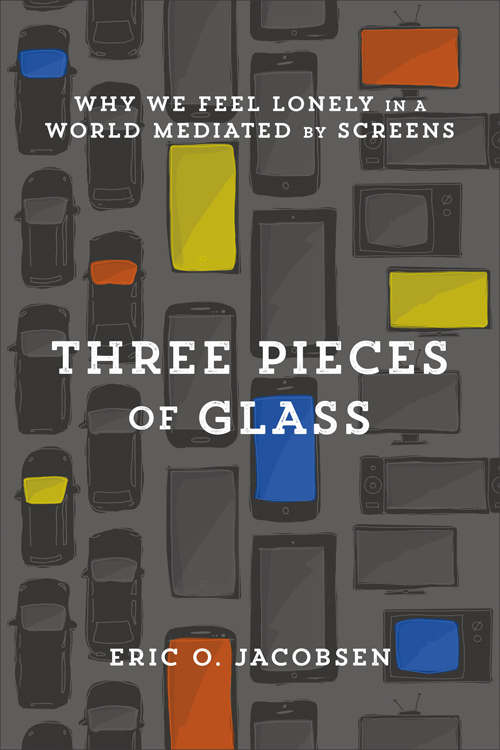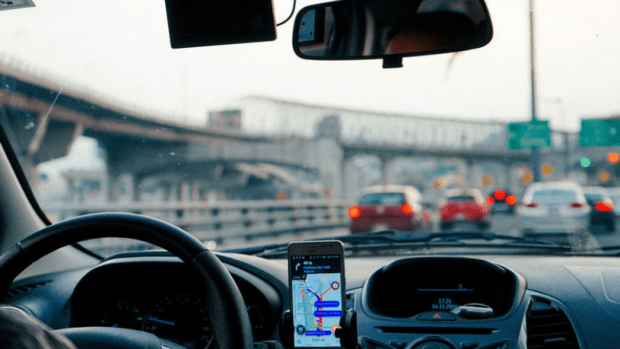At first glance, Christianity and urban planning doesn’t seem to mix unless you’re talking about how Puritans settlers oriented colonial town squares in the 17th century. But author Eric Jacobsen, a pastor at First Presbyterian Church in Tacoma, has a thought-provoking book, “Three Pieces of Glass,” which discusses how our dependence on cars and the internet has made us less social and lonelier than we used to be.
Jacobsen became interested in planning and zoning as a pastor in Missoula, Montana, in the 1990s when he wanted to help a pizza restaurant take over the lease of a bookstore, but ran afoul of local zoning laws. Now Jacobsen is examining the role automobiles have played in fracturing communities and how walkable neighborhoods go hand-in-hand with stronger congregations. He sat down with Streetsblog emeritus gris Aaron Short. The following is a condensed version of their spiritual conversation.

Your book’s title references three pieces of glass: windshields, televisions and phones. What do windshields have in common with phones?
I was trying to be sneaky. My problem is I end up preaching to the choir. You have people who see the world as we see it. I work with a lot of elderly folks in my church who are attuned to the problems of cell phones and see the antisocial tendencies. They’re not beholden to their phones, but they love their automobiles and they tend to bristle about [restrictions on] cars in the cities
Part of what I’m doing is saying that these things are connected. The second half of the 20th century was about spreading things out further and further, which guaranteed that you would spend more time in your car, and then turning your house around so they’re oriented to your backyard and you don’t talk to neighbors on the front porch. We’ve limited the ways in which we connect with neighbors. It’s part of a comprehensive plan to prevent you from having interactions with someone you don’t already know.
Why is there so much road rage among drivers?
In the car, we don’t encounter each other as fellow humans, but as competitors. A car takes up a lot of space. We’re competitors for lane space and parking space. The other driver represents a danger. A drunk driver is a health risk to your family or yourself. We’re afraid of each other and we’re not accountable in a way that we are in face-to-face or on-foot interactions.
If I say something rude to someone walking on the street, they’re either going to push back or I’m going to see that it hurt their feelings. But in a car, I can start yelling and I can build up a lot of rage. There’s no accountability there. I’m in the silence of my bubble, and I can say what I want. It insulates us from our natural abilities to connect with fellow humans.
You reference secular liturgy for vehicles in your book. Can you explain what you mean?
The idea of secular liturgy is something I borrowed from James K.A. Smith. His larger point is we’re not as rational as we think we are and we’re led by habit and patterns. He thinks that what forms us isn’t world views or things we read in the paper or the bible. It’s the habits we follow.

Driving is a kind of liturgy. It’s a sense of power. You turn the key and push the accelerator and you can overcome the problem of distance. Cyclists have to think about hills they’re constantly thinking about the elevation game. But drivers don’t know the hills in their town they don’t have to think about it. They can just push the accelerator. They’re being trained in the basic tenets of modernity. That man has power over nature. The individual is the most powerful unit.
Standardization is the way to conquer all problems. When you drive the car you’re reminded over all the things. But for each of the things there is shadow side. We have power over nature but there’s climate change and species extinction. Autonomy is great but we’re super lonely. And we can build more houses and cheaper but they look like crap.
There’s surprising delights in riding bikes or walking. I I have to work harder to get up this hill and it’s going to get me in shape and I am more attuned with spring and the environment. If I drive a car, I become a jerk like everyone else.
How have churches affected city planning and walkability within their neighborhoods?
Churches have a lot of land and a lot of churches, especially growing churches, tied to acquire as much land as they could to build big parking lots. The American church is always going to need some kind of parking. We don’t have a parish model — parishioners are going to drive — but as communities become denser, we need to be aware of the fact that a lot of people are going to want to walk. And we need to think about what to do with that land. You could build affordable housing on that lot and get a revenue stream from that as well.
Churches had a habit of moving out of neighborhoods and building around suburbs. There’s a different paradigm, there’s still largely the case that churches think in a suburban mentality. A pre-World War II church is going to come up right to the sidewalk, and if there’s parking at all, it’s going to be in the back. But if you look at any church in the 20th century, it’s plopped in the middle of a parking lot, the front doors aren’t going to be prominent at all, and there are huge billboards that communicate to drivers on a highway.
What can urban planners and faith leaders learn from the other?
The first interaction churches often have with a planning department is getting permission to doing something they want to do and an us-against-them relationship happens. It would be great for churches to develop relationships with people in government, not necessarily planing departments, to discuss what are some of the problems in our neighborhood and can we think of ways we can be helpful.
They have a lot of overlapping goals as well. Churches can provide non-commercial meeting spaces. They can have a community forum where light rail is going to go for example, and we’re happy to open our doors for that.
How do we shift infrastructure away from favoring cars?
We should spend less money on freeways and lane widening and all those things we know that increase traffic. I like what [UCLA professor] Donald Shoup says about putting appropriate price tags on parking and congestion. That’s the easy answer. The hard question is how do you get enough buy-in from people from the beginning?
I went to school in Pasadena, an area that predates the Los Angeles freeway world. It was built prior to the automobile. It has the infrastructure for walking and biking in southern California, but culturally that’s not what people do. On the first day of school, we got on our bikes and rode. We asked the principal, “Where’s the bike rack?" And the principal said, “We don’t have any bikes, but you can put your bike in my office.”
Parents noticed that we were getting to school way faster than they did. By the end of our time there, we had a cadre of parents biking to school and three or four bike racks installed because there was demand for it. There was a ton of benefits for cycling to school. We need people on the ground to model and invite neighbors to join them.
Cars are now coming fully outfitted with iPad-like screens to watch a movie or use social media. How can you counteract that trend?
One of the things we’re seeing is a lot of wealthy folks opting away from technology and screens. Silicon Valley executives are sending their kids to Waldorf schools. The privilege is to not have to deal with screens all the time. I’m not sure if that technology with cars is necessarily going to win over everyone. There’s some resistance to these things and I don’t see it sweeping the nation. I think there are more intelligent people who have the means will see this as, “That’s the stupidest thing ever” and have the privilege not to get into a car.
My definition of post-modernity is a waning enthusiasm for modernity. To be the ruler of your own universe is less compelling than it used to be. It’s waning. And the desperation out there to sell us on something that less and less people want.






